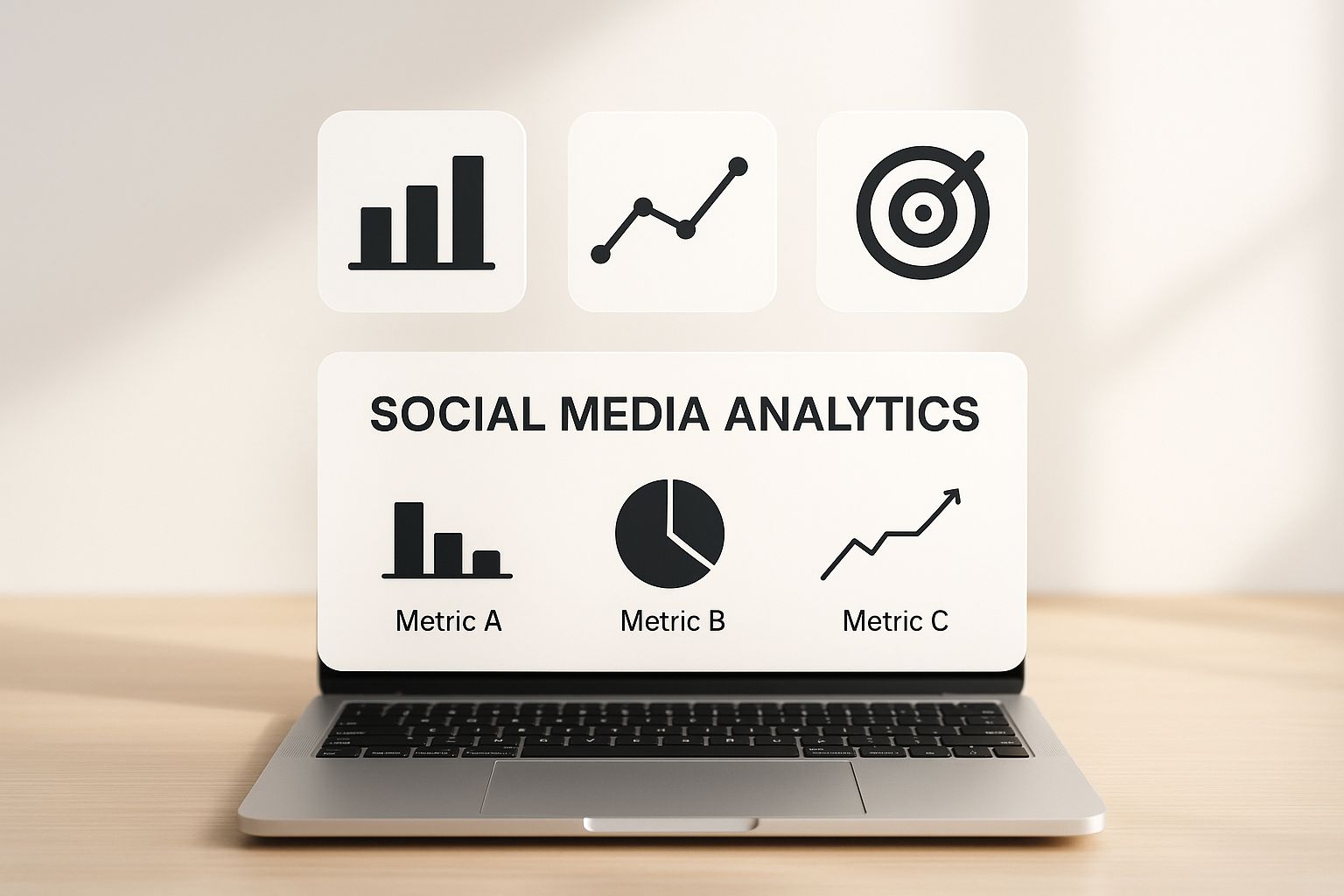Let's be honest, "sales activity tracking" sounds a lot like micromanagement. I get it. But we need to get past that old-school way of thinking. In reality, it’s the secret sauce for any modern sales team.
Think of it as the navigation system for your entire sales operation. Without it, your reps are essentially flying blind, pouring energy into calls and emails that go nowhere, and missing out on deals they should be closing.
When you start properly tracking the right activities, you shift from guesswork to a predictable, scalable growth machine. This isn't about watching over your team's shoulder; it's about giving them a roadmap. Once you know which specific actions lead to a signed contract, you can help your team focus on what actually works.
From Messy Notes to Smart Insights
It wasn't always this way. I remember the days of crumpled call sheets and scribbled notes in a binder. Trying to pull any meaningful insights from that was a nightmare, if not impossible.
Thankfully, we've moved on. Now, this kind of tracking is a fundamental part of any good Customer Relationship Management (CRM) system or specialized sales platform.
This diagram from Wikipedia’s page on CRM shows just how central these systems have become.
You can see how a CRM pulls everything together—sales, marketing, customer service—into one place. This is what makes modern activity tracking so powerful. Every single touchpoint can be logged and analyzed, giving you a complete picture of the customer journey.
Why Data is Now Driving Sales
This isn't just a fleeting trend. It’s a seismic shift in how B2B sales get done. The future of sales is almost entirely digital. In fact, by 2025, digital channels are expected to handle a staggering 80% of all B2B sales interactions.
On top of that, 74% of sales professionals believe AI will fundamentally change how they work, pushing us all towards smarter, more automated tools. You can dig into more sales automation statistics to see just how fast things are changing.
The real win here isn't just seeing what your team is doing—it's about being able to predict what will happen next. Meticulous tracking gives you a healthier pipeline, more accurate forecasts, and a clear view of the exact actions that bring in revenue. You’re essentially turning sales from an art into a science.
Building Your Tracking Foundation
Before you even think about tracking a single call or email, you need to lay some serious groundwork. A lot of teams mess this up. They get excited about new tools and start tracking everything, but they never stop to define what "good" actually looks like for their business. This turns your tracking efforts into a glorified data collection project instead of a strategic advantage.

The first real step isn't picking software; it’s tying your sales goals to tangible business outcomes. A vague goal like "make more calls" is useless. A strong foundation is built on specific, results-focused objectives. For example, aiming to increase the demo-to-close ratio by 15% this quarter is a measurable goal that directly hits the bottom line.
This simple shift in thinking forces you to get critical about which activities truly move the needle.
Map Your Entire Sales Process
So, how do you find those critical activities? You have to visualize your entire sales process, from the first "hello" to the final signed contract. This means getting granular and documenting every single stage a prospect moves through.
For a lot of B2B companies, that journey looks something like this:
- Initial Contact: The very first touchpoint—a cold email, a webinar signup, an inbound form fill.
- Qualification: Figuring out if the lead is actually a good fit based on your criteria.
- Discovery Call: That first real conversation where you dig into their pains and needs.
- Product Demo: The "show and tell" where you connect your solution to their specific problems.
- Proposal Sent: Submitting the formal offer with pricing and all the details.
- Negotiation: The back-and-forth to iron out the final agreement.
- Closed-Won: The deal is signed, and you’ve got a new customer.
Mapping this out gives you a clear roadmap. You immediately see where to focus your tracking to get the most bang for your buck.
The real goal here is to move beyond tracking for tracking's sake. When your process is clearly defined, you can pinpoint which activities have the biggest impact at each stage. That's how you turn raw data into a powerful coaching tool.
Separate Vanity Metrics from Actionable KPIs
With your process mapped, you can finally start to separate the metrics that just look good from the ones that actually drive growth. This is a make-or-break step.
- Vanity Metrics: These are the numbers that look impressive on a dashboard but don't correlate to results. Think total emails sent or hours logged on the phone. Effort is great, but being busy doesn't mean you're being effective.
- Actionable KPIs (Key Performance Indicators): These are directly tied to sales outcomes. They tell you if your strategy is actually working by measuring effectiveness, not just activity.
At the end of the day, effective sales activity tracking is all about optimizing your pipeline and getting better at forecasting. And let's be honest, revenue is the ultimate KPI, covering everything from the initial sale to upselling down the road. I've seen it time and again: businesses that obsessively monitor their pipeline stages are far better at predicting conversions and managing their resources. For a deeper dive, you can explore the top sales metrics for B2B success on inaccord.com.
Getting this foundation right ensures every bit of effort is tied to what truly matters—growing the business.
Choosing and Setting Up Your Sales Tech Stack
Technology is the engine that drives modern sales activity tracking, and a Customer Relationship Management (CRM) system sits right at its heart. But just having a CRM isn't the finish line. The real goal is to choose and configure technology that actually helps your team, making their jobs easier—not burying them in a mountain of administrative busywork.
When you get it right, your tech stack should feel almost invisible. It needs to blend seamlessly with the tools your team already lives in, like their email and calendars, to automate all that tedious data entry. Imagine a setup where every call, email, and meeting is logged automatically. That frees up your reps to do what they're paid to do: build relationships and close deals.
Aligning Your CRM with Your Sales Goals
Your CRM configuration should be a direct mirror of the sales process you've already mapped out. This is where you move beyond the default settings and really make the tool your own. It's about customizing the platform to track the specific activities and metrics that genuinely matter to your business.
For instance, let’s say the "Product Demo" is a make-or-break stage in your sales cycle. You’d want to create custom fields to capture critical information right then and there:
- Demo Outcome: (e.g., "Positive, Proposal Requested," "Needs Follow-up," "Not a Fit")
- Key Pain Points Discussed: A simple text field to jot down the prospect's main challenges.
- Next Action Agreed: The specific next step everyone committed to during the demo.
This level of detail transforms your CRM from a passive database into a strategic weapon, giving you real-time intelligence on the health of your pipeline.
The guiding principle is simple: your technology has to support your strategy, not the other way around. If a tool creates more work than it eliminates, your team just won't use it consistently. Your entire sales tracking initiative will crumble. The best systems are the ones salespeople actually want to use because they can see the direct benefit.
At the core of any efficient system are effective sales automation solutions that handle the repetitive, soul-crushing tasks that bog reps down. When you implement it correctly, automation is a true game-changer. But it’s also easy to get wrong. To make sure you’re setting yourself up for success, take a look at our guide on the top sales automation mistakes to avoid.
Deciding on the right CRM often comes down to your current stage of growth. A startup's needs are very different from a team that's scaling rapidly. This table breaks down the features you'll want to consider.
Essential vs. Advanced CRM Features for Sales Tracking
| Feature | Essential for Startups | Advanced for Scaling Teams |
|---|---|---|
| Contact Management | Basic contact and company records. | 360-degree customer view, relationship mapping. |
| Deal/Pipeline Tracking | Simple, visual pipeline stages. | Multiple pipelines, advanced forecasting. |
| Email Integration | Log emails manually or with a basic plugin. | Two-way sync, automated email sequences. |
| Activity Logging | Manual entry for calls and meetings. | Automatic call logging, meeting transcription. |
| Reporting | Pre-built dashboards for basic metrics. | Custom report builder, granular analytics. |
| Automation | Simple task reminders and notifications. | Complex workflow automation, lead scoring. |
Ultimately, choose a tool that not only meets your needs today but also has the advanced capabilities you'll need as you grow.
The Impact of a Well-Implemented CRM
The value of a properly tuned CRM is undeniable. Its effect on productivity and revenue isn't just talk; it's been documented across just about every industry you can think of.

As you can see, a strategic tech setup allows for precise measurement against clear targets, which directly fuels team performance. It’s no surprise, then, that an incredible 94% of businesses report a jump in sales productivity after bringing a CRM on board.
The numbers speak for themselves: companies can see up to a 29% increase in sales and a 42% improvement in forecast accuracy. This data really highlights how a central system can transform sales activity tracking from a chore into a powerful driver for growth.
In the end, your tech stack should deliver clarity, not complexity. It's the plumbing that enables your team to execute your sales strategy efficiently, predictably, and successfully.
Tracking the Right Activities and Metrics
Alright, let's get into the nitty-gritty of what your sales activity tracking should actually capture. Simply counting up calls and emails just doesn’t fly anymore. If you want to build a system that delivers real insight, you have to connect the daily grind of your reps to the results that actually move the needle for the business.
This means looking at the full picture—both leading and lagging indicators. Think of it this way: leading indicators are the activities your team has direct control over, day in and day out. Lagging indicators are the outcomes you’re aiming for.
Linking Effort to Outcomes
The real magic happens when you can draw a straight line from a specific effort to a specific outcome. Leading indicators are your inputs; lagging indicators are your outputs. A well-designed tracking system makes this relationship crystal clear, so you stop measuring busyness and start measuring effectiveness.
For example, if you see a rep making 100 calls a week (a leading indicator) but only booking 2 demos (a lagging indicator), you’ve just uncovered a perfect coaching moment. The problem isn’t a lack of effort—it's somewhere in their approach, their script, or their targeting.
A balanced scorecard needs a healthy mix of both:
- Leading Indicators (The Effort): These are the day-to-day actions.
- Number of new contacts added
- Calls made and emails sent
- Demos or meetings scheduled
- Proposals sent out
- Lagging Indicators (The Results): These measure the impact of all that effort.
- Conversion rate from demo to proposal
- Average sales cycle length
- Average deal size
- Win rate percentage
This approach also gives reps the power to course-correct on their own. When they can clearly see that Activity X is what consistently leads to Result Y, they’ll naturally start doing more of what works.
By focusing on both effort and outcomes, you create a powerful feedback loop. Reps finally understand which activities generate the best results. And leaders get the data they need to move the conversation from, "Did you hit your numbers?" to, "How can we make your activities more effective?"
Prioritizing High-Impact Activities
Let's be honest: not all sales activities are created equal. The secret to great sales activity tracking is zeroing in on the handful of actions that have an outsized impact on closing deals. And what's most important often changes depending on where a prospect is in your sales funnel.
Early on, during prospecting, the most critical activity might be personalizing that first outreach email just enough to land a discovery call. But later in the cycle, the pivotal moment becomes the product demo and how well it connects to the prospect's specific pain points.
Automating the logging of these key activities is a game-changer. I’ve seen it firsthand. Companies that use automation and AI don't just reduce human error by 20%; they also report a 10-20% bump in ROI. This gives reps back around 5 hours a week—time they can reinvest in those high-value interactions instead of tedious data entry. If you want to dig into the numbers, check out these sales automation stats.
Ultimately, a sharp focus on the right metrics transforms tracking from a chore your reps hate into a strategic weapon. It creates a clear, shared roadmap of what it takes to win, empowering everyone on your team to perform at their absolute best.
Turning Sales Data Into Actionable Insights
Collecting data is just the starting line. The real magic happens when you turn all those numbers into smarter decisions that help your team actually win more deals. Think of your CRM dashboard as ground zero for this entire process—it's where raw sales activity data starts telling a clear story about what’s working and what isn’t.

This is the jump from just seeing numbers to truly understanding them. A well-designed dashboard doesn’t just spit data at you; it points out trends, flags potential problems before they get out of hand, and celebrates wins in real time.
Building and Reading Your Dashboard
Your dashboard should never be a cluttered mess of every metric under the sun. That’s a recipe for analysis paralysis. Instead, it should be a focused command center displaying the handful of KPIs that directly reflect your sales process and goals. It’s your sales team's vital signs monitor.
A great dashboard answers your most pressing questions at a glance:
- Which reps are consistently booking the most demos?
- Where in the pipeline are most of our deals stalling out?
- What’s our average response time to a fresh inbound lead?
Answering these helps you spot patterns fast. For instance, if one rep is booking a ton of meetings but has a dismal close rate, that's a blinking red light. It tells you they likely need some coaching on their qualification process or maybe their demo technique is off. This is what making data actionable looks like. For more ideas on what to track, check out our guide on key sales performance metrics examples.
The whole point of your dashboard is to trigger a specific action. If you look at a metric and have no idea what to do about it, that metric probably doesn't belong on your main dashboard. Every single chart should lead to a question, a conversation, or a decision.
From Insights to Targeted Coaching
Once you've spotted a trend, the next move is to use that insight to drive real improvement. This is where you level up from a manager who just reads off numbers to a coach who actually develops talent.
Let’s say your dashboard shows a team-wide drop in the number of calls being logged. Instead of the classic "we need more calls!" speech, you can dig deeper. Are your reps buried in admin work? Is the lead quality tanking? The data gives you a solid place to start a productive, fact-based conversation.
With 87% of businesses now using cloud-based CRMs, this data has never been more accessible. On top of that, 88% of sales leaders believe AI will significantly improve CRM processes in the next couple of years, making analytics even sharper.
Continuous Process Refinement
The insights you pull from sales activity tracking aren't just for one-off coaching sessions. They are the fuel you need to continuously fine-tune your entire sales process. For a deeper dive into data visualization, it's worth seeing how other teams go about building a custom analytics dashboard.
This constant loop of tracking, analyzing, and adjusting is what builds predictable, scalable growth. When you use real-world data to guide your decisions, you stop guessing and start building a system that just gets better over time.
Got Questions About Sales Tracking? Let's Talk.
Even with a killer plan and the right tools, you're bound to hit some snags. Rolling out a new sales tracking system is a major shift, and it's completely normal for reps and leaders to have questions. Let's tackle some of the most common ones I hear all the time.
How Do I Get My Sales Team to Actually Use the CRM?
Ah, the million-dollar question. The secret is to completely reframe it. Stop thinking of it as a management tool and start pitching it as a personal sales assistant. It's not about watching their every move; it's about helping them close more deals.
The best way I've found to do this is to hammer home the "what's in it for them" angle. Show them exactly how automation slashes their boring admin time. Demonstrate how the data points them directly to the hottest leads in their pipeline. Even better, get them involved in the setup process. When they help build the workflows, they feel a sense of ownership, and you can be sure the system actually makes their lives easier.
What Is the Difference Between an Activity and Performance Metric?
It's super easy to get these mixed up, but telling them apart is crucial for tracking what really matters.
- Activity Metrics are all about the effort your team is putting in. Think of these as the inputs: calls made, emails sent, new contacts added.
- Performance Metrics measure the results of that effort. These are the outputs that hit the bottom line: your conversion rates, average deal size, and sales cycle length.
A solid tracking system needs both. It's the only way to know if your team is just busy, or if they're being productively busy.
An imbalance between these two is a huge red flag. A ton of activity with poor performance usually means you need to do some coaching on strategy. On the flip side, low activity but high performance might signal a star rep who could be crushing it even more with a little support.
Can You Track Too Many Sales Metrics?
Absolutely. In fact, it's one of the biggest mistakes I see teams make. You get so buried in data that you fall into "analysis paralysis"—spending all your time looking at numbers and no time actually acting on them. It kills momentum.
The fix? Be ruthless about what you focus on. Start by picking the 3-5 key metrics that are tied directly to your main business goals. For most sales teams, this will be stuff like win rate, sales cycle length, and deal size.
Only add a new metric if it answers a specific, burning question that your current metrics can't. When it comes to data, quality of insight will always beat quantity of numbers. For more on this, check out our guide on sales prospecting best practices.
How Often Should We Review Sales Activity Data?
The perfect rhythm really depends on your sales cycle, but there’s a general framework that works for most teams.
- Daily/Weekly Individual Check-ins: Reps should be glancing at their personal dashboards every day or two. This helps them self-manage their pipeline and figure out where to focus their energy.
- Weekly Team Reviews: These meetings are gold for spotting quick trends, celebrating wins, and clearing out any roadblocks as a team.
- Monthly/Quarterly Deep Dives: This is where you zoom out. Use these sessions to look at the bigger picture, check the health of your overall strategy, and make significant tweaks to your sales process.
Honestly, consistency is way more important than frequency. Just make sure these reviews become a non-negotiable part of your team's routine.
Ready to stop guessing and start growing? Salesloop.io provides the tools you need to automate outreach, track what works, and turn your sales data into your most powerful asset. Start your free trial today and see how a smarter approach to sales activity tracking can accelerate your pipeline.





